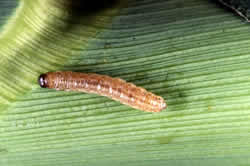Benefits of Genetic Engineering
Genetically engineered organisms can offer a range of benefits that would be difficult to obtain using traditional agricultural methods. Following are a few examples of benefits that can be obtained by applying currently available GE technology. Over 50 crops have been approved, but most are not in commercial use.
 Insect resistance
Insect resistance
Bacillus thuringiensis (Bt) is a common soil bacterium that has safely been used by organic farmers as a natural pesticide. Bt creates a protein that is toxic to specific insect larva, but is harmless to mammals. The gene for this protein has been genetically engineered into plants to make them insect resistant. This resistance reduces the number of times farmers spray with insecticides. The two most common Bt crops are Bt cotton (modified to control budworms and bollworms) and Bt corn (modified to provide protection against the European corn borer). Bt crops have higher production when there is a high level of insect infestation.
Bt crops in commercial use are corn and cotton. Bt crops in development include sunflower, soybean, canola, wheat, and tomatoes.
Herbicide resistant crops (HRCs)
The insertion of a herbicide tolerant gene enables farmers to spray wide-spectrum herbicides on the crop fields, killing all the weeds without hurting the crop. The most common HRC are tolerant to glyphosate and and glufosinate ammonium, which are active ingredients of common wide-spectrum herbicides that are rapidly broken down in the field.
 Many farmers choose to use HRC because they can spray fewer times and do not have to till the soil as often. This reduces the amount of chemical exposure that the workers have and aids soil conservation. Glyphosate and glufosinate have less potential for soil and water contamination than the herbicides that they replace.
Many farmers choose to use HRC because they can spray fewer times and do not have to till the soil as often. This reduces the amount of chemical exposure that the workers have and aids soil conservation. Glyphosate and glufosinate have less potential for soil and water contamination than the herbicides that they replace.
HT crops: corn, soybean, cotton, canola, sugarbeets, rice, flax. Future HT crops: wheat.
Disease resistance
Disease resistance can be obtained by transferring a gene from a plant or organism that has natural resistance or by creating a "vaccine" using a part of the virus DNA.
 For example, researchers from the University of Hawaii and Cornell University developed papaya ringspot virus resistant plants by by transferring a gene for the virus protein coat directly into the papaya genome. No papayas have natural resistance to this virus, so traditional breeding methods were not an option. ‘SunUp’ papaya seeds and the hybrid, ‘Rainbow’, have been distributed to papaya growers, free, since May of 1998.
For example, researchers from the University of Hawaii and Cornell University developed papaya ringspot virus resistant plants by by transferring a gene for the virus protein coat directly into the papaya genome. No papayas have natural resistance to this virus, so traditional breeding methods were not an option. ‘SunUp’ papaya seeds and the hybrid, ‘Rainbow’, have been distributed to papaya growers, free, since May of 1998.
Virus/disease resistance: papaya, potato, squash. Disease resistant crops in development: sweet potatoes, cassava, rice, corn, squash).
Enhanced nutrition
Genetic research has focused on improving the nutritional quality of canola oil by enhancing the vitamin E content and by modifying the balance of fatty acids.
Altered oil content: canola, soybean.
Delayed ripening
 The aim of this technology is to delay the ripening process that causes rotting without affecting natural flavor development. Fruit ripening and softening are caused in part by enzymes. Inhibition of this enzymes activity by expression of antisense mRNA delays the ripening process. FLAVR SAVR tomato was the first genetically engineered food approved for human consumption in the USA.
The aim of this technology is to delay the ripening process that causes rotting without affecting natural flavor development. Fruit ripening and softening are caused in part by enzymes. Inhibition of this enzymes activity by expression of antisense mRNA delays the ripening process. FLAVR SAVR tomato was the first genetically engineered food approved for human consumption in the USA.
Delayed fruit ripening: FLAVR SAVR tomato (no longer marketed).
Pollen control
 Scientists have used genetic engineering to develop male-sterile varieties using a two-gene system from a soil bacterium. Male-sterile varieties of plants are engineered by making them produce an enzyme, barnase, in the pollen-producing tissues, blocking pollen production. A second variety is engineered to express barstar. When pollen from the barstar plant is used to fertilize the male-sterile barnase plants (which can't fertilize itself), the resulting hybrid will be fully fertile, because it will have the genes for both barstar and barnase together.
Scientists have used genetic engineering to develop male-sterile varieties using a two-gene system from a soil bacterium. Male-sterile varieties of plants are engineered by making them produce an enzyme, barnase, in the pollen-producing tissues, blocking pollen production. A second variety is engineered to express barstar. When pollen from the barstar plant is used to fertilize the male-sterile barnase plants (which can't fertilize itself), the resulting hybrid will be fully fertile, because it will have the genes for both barstar and barnase together.
Pollen control: corn, chicory.

